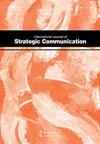Active Employee Communication Roles in Organizations: A Framework for Understanding and Discussing Communication Role Expectations
IF 1.9
Q1 COMMUNICATION
International Journal of Strategic Communication
Pub Date : 2022-01-01
DOI:10.1080/1553118X.2021.2014503
引用次数: 4
Abstract
ABSTRACT Several scholars have pointed out the importance of employees’ strategic communication behaviors for organizational performance and employee wellbeing. Employees contribute to organizations by acting as brand ambassadors, boundary spanners and crisis communicators. Employees play such roles on top of assigned job tasks, which can lead to role overload, role conflicts and job stress. The analysis of employees’ communication role enactment is hampered by the lack of a framework describing the complete range of active communication roles that employees are expected to play in the workplace. This article introduces the Active Employee Communication Roles (AECR) Framework (AECR), develops the conceptualization of eight communication roles, and discusses implications for strategic communication. The first four roles – the embodier, promotor, defender, and relationship builder role – describe ambassador roles. In addition, employees play the roles of scout, sensemaker, innovator, and critic to contribute to organizational development. The AECR framework provides a new lens which aids our understanding of the relationship between communication, and employee performance and wellbeing, and provides employees and employers a tool to analyze and calibrate mutual expectations regarding communication behaviors. The framework can also help employees to more strategically allocate resources when executing the various communication roles. This may help to alleviate employee role stress, and create healthier workplaces.组织中积极的员工沟通角色:一个理解和讨论沟通角色期望的框架
一些学者指出了员工战略沟通行为对组织绩效和员工幸福感的重要性。员工通过充当品牌大使、边界跨越者和危机传播者为组织做出贡献。员工在分配的工作任务之上扮演这样的角色,这会导致角色过载、角色冲突和工作压力。由于缺乏描述员工在工作场所期望扮演的主动沟通角色的完整范围的框架,对员工沟通角色设定的分析受到阻碍。本文介绍了主动员工沟通角色(AECR)框架(AECR),发展了八种沟通角色的概念,并讨论了战略沟通的含义。前四个角色——体现者、推动者、捍卫者和关系建设者——描述了大使的角色。此外,员工还扮演着侦察员、感知者、创新者和批评者的角色,为组织的发展做出贡献。AECR框架提供了一个新的视角,帮助我们理解沟通与员工绩效和幸福感之间的关系,并为员工和雇主提供了一个分析和校准沟通行为相互期望的工具。该框架还可以帮助员工在执行各种通信角色时更有战略地分配资源。这可能有助于减轻员工的角色压力,创造更健康的工作场所。
本文章由计算机程序翻译,如有差异,请以英文原文为准。
求助全文
约1分钟内获得全文
求助全文
来源期刊

International Journal of Strategic Communication
Social Sciences-Sociology and Political Science
CiteScore
3.40
自引率
0.00%
发文量
39
期刊介绍:
The International Journal of Strategic Communication examines the philosophical, theoretical, and applied nature of strategic communication, which is “the purposeful use of communication by an organization to fulfill its mission.” IJSC provides a foundation for the study of strategic communication from diverse disciplines, including corporate and managerial communication, organizational communication, public relations, marketing communication, advertising, political and health communication, social marketing, international relations, public diplomacy, and other specialized communication areas. The IJSC is the singular forum for multidisciplinary inquiry of this nature.
 求助内容:
求助内容: 应助结果提醒方式:
应助结果提醒方式:


